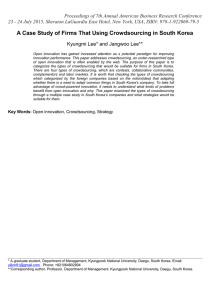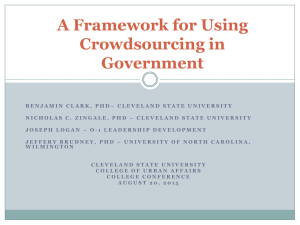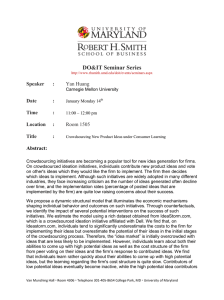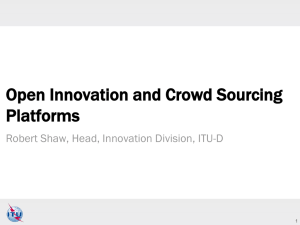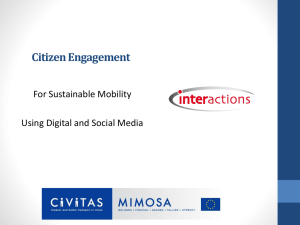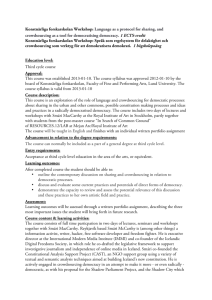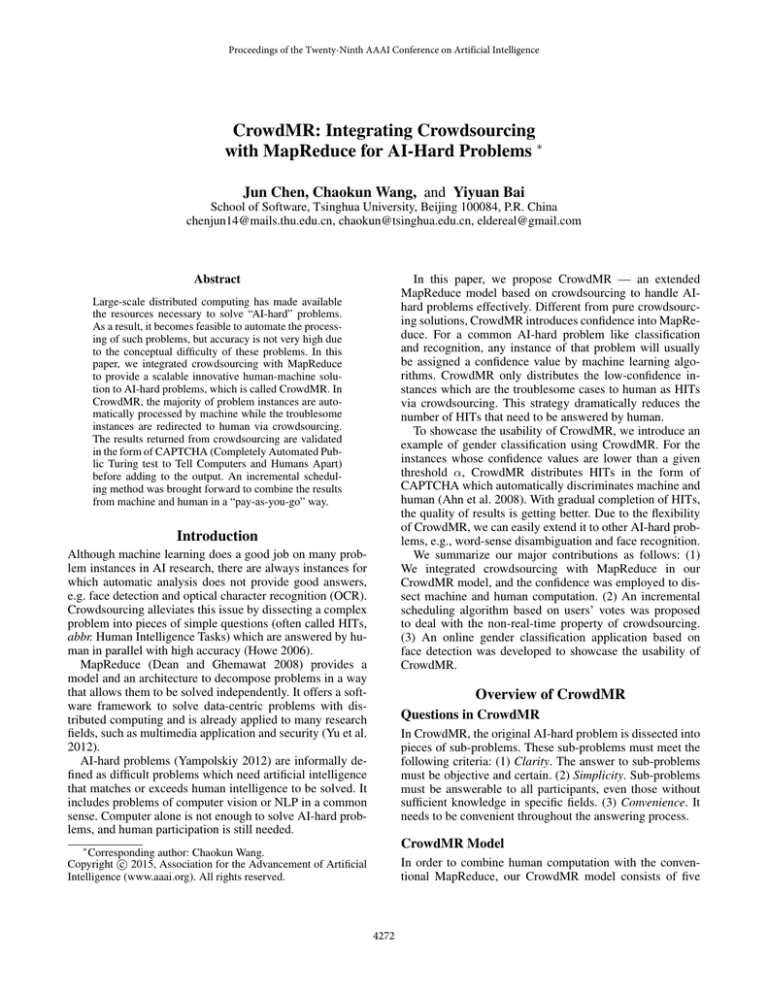
Proceedings of the Twenty-Ninth AAAI Conference on Artificial Intelligence
CrowdMR: Integrating Crowdsourcing
with MapReduce for AI-Hard Problems ∗
Jun Chen, Chaokun Wang, and Yiyuan Bai
School of Software, Tsinghua University, Beijing 100084, P.R. China
chenjun14@mails.thu.edu.cn, chaokun@tsinghua.edu.cn, eldereal@gmail.com
Abstract
In this paper, we propose CrowdMR — an extended
MapReduce model based on crowdsourcing to handle AIhard problems effectively. Different from pure crowdsourcing solutions, CrowdMR introduces confidence into MapReduce. For a common AI-hard problem like classification
and recognition, any instance of that problem will usually
be assigned a confidence value by machine learning algorithms. CrowdMR only distributes the low-confidence instances which are the troublesome cases to human as HITs
via crowdsourcing. This strategy dramatically reduces the
number of HITs that need to be answered by human.
To showcase the usability of CrowdMR, we introduce an
example of gender classification using CrowdMR. For the
instances whose confidence values are lower than a given
threshold α, CrowdMR distributes HITs in the form of
CAPTCHA which automatically discriminates machine and
human (Ahn et al. 2008). With gradual completion of HITs,
the quality of results is getting better. Due to the flexibility
of CrowdMR, we can easily extend it to other AI-hard problems, e.g., word-sense disambiguation and face recognition.
We summarize our major contributions as follows: (1)
We integrated crowdsourcing with MapReduce in our
CrowdMR model, and the confidence was employed to dissect machine and human computation. (2) An incremental
scheduling algorithm based on users’ votes was proposed
to deal with the non-real-time property of crowdsourcing.
(3) An online gender classification application based on
face detection was developed to showcase the usability of
CrowdMR.
Large-scale distributed computing has made available
the resources necessary to solve “AI-hard” problems.
As a result, it becomes feasible to automate the processing of such problems, but accuracy is not very high due
to the conceptual difficulty of these problems. In this
paper, we integrated crowdsourcing with MapReduce
to provide a scalable innovative human-machine solution to AI-hard problems, which is called CrowdMR. In
CrowdMR, the majority of problem instances are automatically processed by machine while the troublesome
instances are redirected to human via crowdsourcing.
The results returned from crowdsourcing are validated
in the form of CAPTCHA (Completely Automated Public Turing test to Tell Computers and Humans Apart)
before adding to the output. An incremental scheduling method was brought forward to combine the results
from machine and human in a “pay-as-you-go” way.
Introduction
Although machine learning does a good job on many problem instances in AI research, there are always instances for
which automatic analysis does not provide good answers,
e.g. face detection and optical character recognition (OCR).
Crowdsourcing alleviates this issue by dissecting a complex
problem into pieces of simple questions (often called HITs,
abbr. Human Intelligence Tasks) which are answered by human in parallel with high accuracy (Howe 2006).
MapReduce (Dean and Ghemawat 2008) provides a
model and an architecture to decompose problems in a way
that allows them to be solved independently. It offers a software framework to solve data-centric problems with distributed computing and is already applied to many research
fields, such as multimedia application and security (Yu et al.
2012).
AI-hard problems (Yampolskiy 2012) are informally defined as difficult problems which need artificial intelligence
that matches or exceeds human intelligence to be solved. It
includes problems of computer vision or NLP in a common
sense. Computer alone is not enough to solve AI-hard problems, and human participation is still needed.
Overview of CrowdMR
Questions in CrowdMR
In CrowdMR, the original AI-hard problem is dissected into
pieces of sub-problems. These sub-problems must meet the
following criteria: (1) Clarity. The answer to sub-problems
must be objective and certain. (2) Simplicity. Sub-problems
must be answerable to all participants, even those without
sufficient knowledge in specific fields. (3) Convenience. It
needs to be convenient throughout the answering process.
CrowdMR Model
∗
Corresponding author: Chaokun Wang.
c 2015, Association for the Advancement of Artificial
Copyright Intelligence (www.aaai.org). All rights reserved.
In order to combine human computation with the conventional MapReduce, our CrowdMR model consists of five
4272
Figure 2: An example of results on different pages.
ple, as shown in Fig. 1, the 1st , 3rd , 4th images are groundtruth questions where the 1st and the 4th are positive and the
3rd is negative, and then the 2nd is the real HIT question. If
a participant gives correct answers to the 1st , the 3rd and the
4th , her answer to the 2nd is also considered reliable.
Figure 1: The main page of CrowdMR.
phases: map-auto, map-human, shuffle-auto, shuffle-human
and reduce. For each input instance, a confidence is obtained
by executing a certain algorithm at the map-auto phase. The
instances with high confidence are directly output, while
those with low confidence are distributed as HITs in the
map-human phase. The pairs output from both map-auto
and map-human are combined before sending to grouping
phase, where the pairs are clustered using their “Keys” with
a certain clustering or classification algorithm (e.g., gender
classification). Grouping phase is also composed of shuffleauto and shuffle-human. The results from shuffle-human via
crowdsourcing are combined with those from shuffle-auto
before sending to reducer.
Considering the non-real-time property of crowdsourcing,
we proposed an incremental scheduling algorithm which
outputs the machine results first, and then updates the results incrementally as more HITs are answered. This procedure provides a “pay-as-you-go” strategy, which means the
result of a job is always accessible after the machine tasks
are finished, and users can always get better results as more
HITs are completed and merged.
Gender Classification
Fig. 2 shows the three major pages in CrowdMR. The map
page shows the output from mapper. We use different colors
to distinguish results with different confidence. Green lines
point to results whose confidence values are larger than the
threshold α and are used as positive ground-truth, while yellow lines point to low-confidence results which are used as
HIT questions. The unlinked results represent the extremely
low-confidence ones and are used as negative ground-truth.
The shuffle page shows the results of gender classification.
The results with higher confidence are shown as solid lines
and generate ground-truth questions in the shuffle-human
phase. The low confidence results are represented by dashed
lines and generate HIT questions. The final gender classification results are shown in the result page. More results
may be shown here along with more HITs being answered.
Acknowledgments
This work was supported in part by the National Natural Science Foundation of China (No. 61373023, No. 61170064)
and the National High Technology Research and Development Program of China (No. 2013AA013204). We thank
Ping Qiu and Yichi Liu for their discussion with the authors.
CrowdMR Application
We show the application of gender classification using our
CrowdMR model. The system contains two major parts: (1)
The front end uses a graphical way to show all the procedures carried out in CrowdMR. It also provides a Crowdsourcing Task Distribution Interface based on CAPTCHA.
(2) The back end executes face detection and gender classification upon the uploaded images. The map phase deals
with face detection while the grouping phase performs classification. The main page of our system is shown in Fig. 1.
References
Ahn, L.; Maurer, B.; McMillen, C.; Abraham, D.; and Blum,
M. 2008. reCAPTCHA: human-based character recognition
via web security measures. Science 321(5895):1465–1468.
Dean, J., and Ghemawat, S. 2008. MapReduce: simplified
data processing on large clusters. Communications of the
ACM 51(1):107–113.
Howe, J. 2006. The rise of crowdsourcing. Wired magazine
14(6):1–4.
Yampolskiy, R. 2012. AI–complete, AI–hard, or AI–easy
– classification of problems in AI. In The 23rd Midwest
Artificial Intelligence and Cognitive Science Conference.
Yu, Z.; Wang, C.; Thomborson, C.; Wang, J.; Lian, S.; and
Vasilakos, A. 2012. Multimedia applications and security in
MapReduce: opportunities and challenges. In Concurrency
and Computation: Practice and Experience, 2083–2101.
Crowdsourcing Task Distribution Interface
Crowdsourcing task distribution interface (CTDI) is the user
interface between our system and participants who answer
HITs. We distribute crowdsourcing tasks as CAPTCHAs.
CAPTCHA can distinguish human from machine to ensure
that the answers obtained from the CTDI are reliable. To
achieve that goal, several HITs are combined to a single
question. The HITs come from 2 groups: (1) Ground-truth
questions which are already validated by human. (2) HIT
questions which need to be answered by human. For exam-
4273


